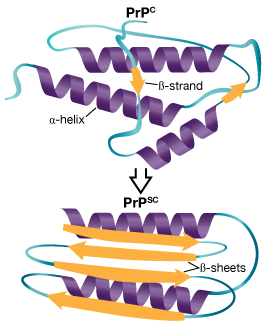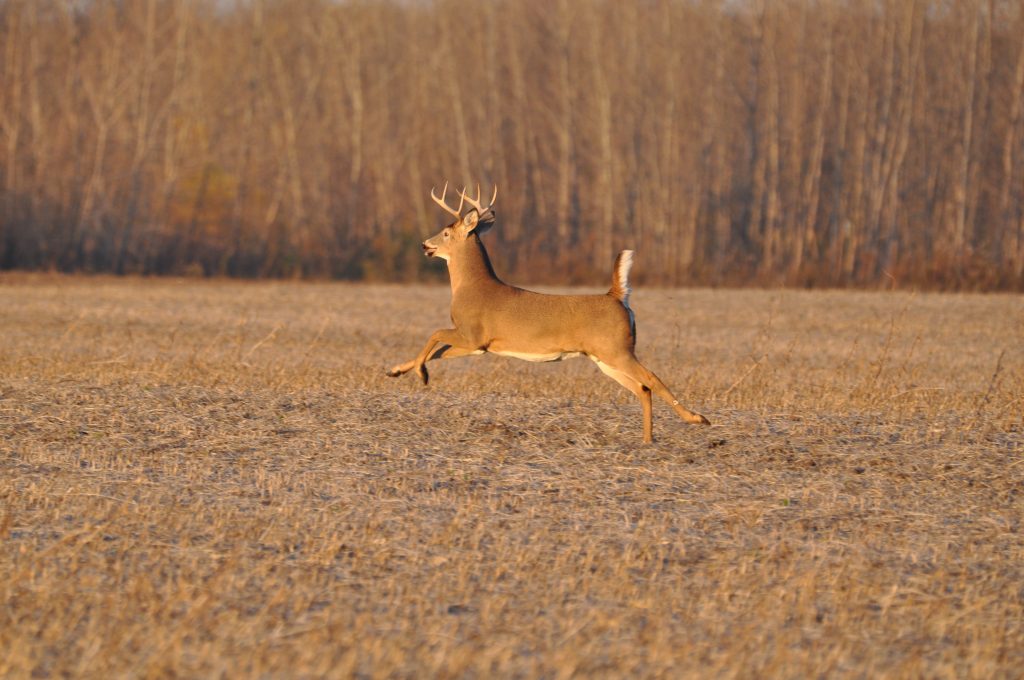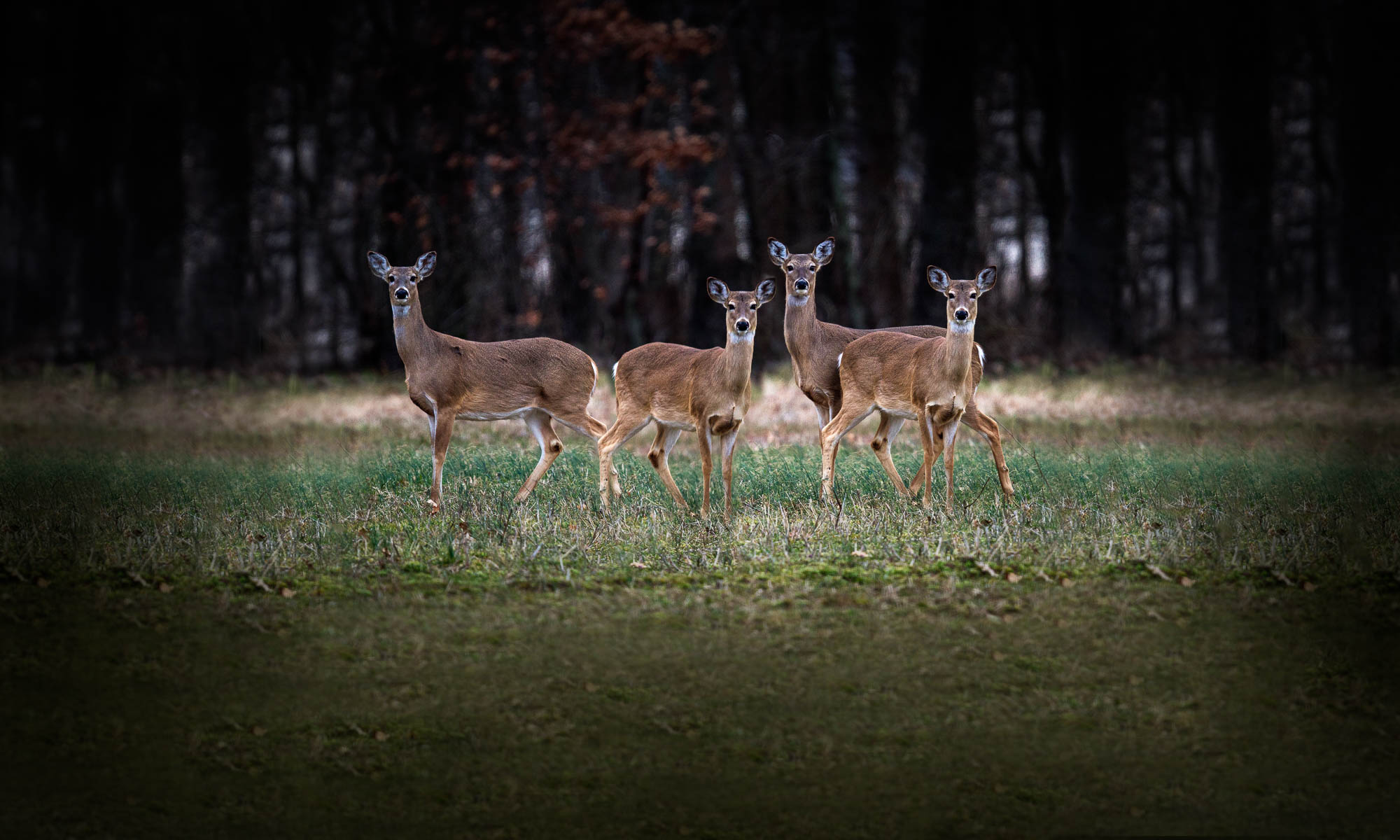Chronic Wasting Disease (CWD) was first documented in Illinois in November 2002; by June 2008, the total number of reported cases of CWD in Illinois was 227. The spread of disease from 5 counties in 2002-2003 (Boone, DeKalb, McHenry, Ogle and Winnebago) to include (LaSalle and Stephenson by 2008), continues to raise concerns associated with the spread of disease within and across state borders.
PrPC and PrPSC structures

CWD continues to be identified in the northern counties of the state of Illinois.
Current scientific knowledge related to CWD transmission, spread, infectious dose and impact on wildlife populations remains limited. Scientific advances related to CWD are slow and closely related to the chronic nature of the disease, the inability to diagnose it based on clinical signs (diagnosis is post mortem), long incubation period among others.
Therefore, the effectiveness of an intervention strategy requires a long term (years) commitment. The evaluation of the effectiveness of such an intervention can only be assess if the intervention strategy has been persistent and continual (across time and space).

For addtional information on the spatial aspects of CWD see Marilyn Ruiz biosketch, College of Veterinary Medicine.
Projects on Chronic Wasting Disease
- Stratify and characterize CWD occurrence in Illinois by habitat use, population density, age and sex distribution, deer genetic structure and CWD management areas.
- Implementation of genetic, geographic and temporal tools to evaluate CWD occurrence and movement in Illinois.
- Examine the relationship between prion polymorphisms and CWD disease status in free-ranging white-tailed deer.
- Evaluation of the geographic variation of coding polymorphisms observed in Illinois and reported in Wisconsin deer 150 km to the northwest.
- Evaluation of the impact and effectiveness of the current CWD control and management strategy in Illinois.
Publications
Mori, J., Novakofski, J., Schlichting, P.E., Skinner, D.J. and Mateus-Pinilla, N., 2022. The impact of maternal infection with chronic wasting disease on fetal characteristics in wild white-tailed deer (Odocoileus virginianus) in Illinois, USA. Theriogenology Wild, p.100010. [PDF]
Tian, T., Halsey, S.J., Rivera, N.A., Brown, W.M., Novakofski, J.E. and Mateus-Pinilla, N.E., 2022. Impact of landcover composition and density of localized deer culling sites on chronic wasting disease prevalence. Preventive Veterinary Medicine, p.105774.
Perrin-Stowe, T.I., Ishida, Y., Terrill, E.E., Beetem, D., Ryder, O.A., Novakofski, J.E., Mateus-Pinilla, N.E. and Roca, A.L., 2022. Variation in the PRNP gene of Pere David’s deer (Elaphurus davidianus) may impact genetic vulnerability to chronic wasting disease. Conservation Genetics, 23(2), pp.313-23.
Varga, C., McDonald, P., Brown, W.M., Shelton, P., Roca, A.L., Novakofski, J.E. and Mateus‐Pinilla, N.E., 2021. Evaluating the ability of a locally focused culling program in removing chronic wasting disease infected free‐ranging white‐tailed deer in Illinois, USA, 2003–2020. Transboundary and Emerging Diseases. [PDF]
Hedman, H.D., Varga, C., Brown, W.M., Shelton, P., Roca, A.L., Novakofski, J.E. and Mateus‐Pinilla, N.E., 2021. Spatial analysis of chronic wasting disease in free‐ranging white‐tailed deer (Odocoileus virginianus) in Illinois, 2008‐2019. Transboundary and Emerging Diseases, 68(4), pp.2376-2383 [PDF]
Perrin-Stowe, T.I., Ishida, Y., Terrill, E.E., Hamlin, B.C., Penfold, L., Cusack, L.M., Novakofski, J., Mateus-Pinilla, N.E., and Roca, A.L., 2020. Prion protein gene (PRNP) sequences suggest differing vulnerability to chronic wasting disease for Florida Key deer (Odocoileus virginianus clavium) and Columbian white-tailed deer (O. v. leucurus). Journal of Heredity. 111(6), pp.564-572 [PDF]
Ishida, Y., Tian, T., Brandt, A.L., Kelly, A.C., Shelton, P., Roca, A.L., Novakofski, J., and Mateus-Pinilla, N.E., 2020. Association of chronic wasting disease susceptibility with prion protein variation in white-tailed deer (Odocoileus virginianus). Prion, 14(1), pp.214-225. [PDF]
Rivera NA, Brandt AL, Novakofski JE, Mateus-Pinilla NE. 2019. Chronic Wasting Disease in Cervids: Prevalence, Impact and Management Strategies. Veterinary Medicine: Research and Reports. October 2019; 10:123—139. [PDF]
Trone‐Launer EK, Wang J, Lu G, Mateus‐Pinilla NE, Zick PR, Lamer JT, Shelton PA, Jacques CN. 2019. Differential gene expression in chronic wasting disease‐positive white‐tailed deer (Odocoileus virginianus). Ecology and Evolution, 9(22), pp.12600-12612 [PDF].
Brandt AL, Green ML, Ishida Y, Roca AL, Novakofski J, Mateus-Pinilla NE. 2018. Influence of the geographic distribution of prion protein gene sequence variation on patterns of chronic wasting disease spread in white-tailed deer (Odocoileus virginianus). Prion, July 22:1-2. [PDF]
Dorak SJ, Green ML, Wander MM, Ruiz MO, Buhnerkempe MG, Tian T, Novakofski JE, Mateus-Pinilla, NE. 2017. Clay content and pH: soil characteristic associations with the persistent presence of chronic wasting disease in northern Illinois. Scientific Reports, 7(1), p.18062. [PDF]
Brandt AL, Kelly AC, Green ML, Shelton P, Novakofski J, Mateus-Pinilla NE. 2015. Prion Protein gene sequence and chronic wasting disease susceptibility in white-tailed deer (Odocoileus virginianus). Prion, 9(6): 449-462 [PDF]
Rivera NA, Mateus-Pinilla NE, Novakofski J, Satterthwaite-Phillips D. 2015. Metals in obex and retropharyngeal lymph nodes of Illinois white-Tailed deer and their variations with sex and CWD status. Prion, 9 (1): 48-58 [PDF]
Green ML, Manjerovic MB, Mateus-Pinilla NE, Novakofski J. 2014. Genetic assignment tests reveal dispersal of white-tailed deer: implications for chronic wasting disease. Journal of Mammalogy, 95(3): 646-654 [PDF]
Kelly AC, Mateus-Pinilla NE, Brown, W, Ruiz MO, Douglas M, Douglas M, Shelton P, Beissel T, Novakofski J. 2014. Genetic Assessment of Environmental Features that Influence Deer Dispersal: Implications for Prion Infected Populations. Population Ecology. 56:327-340.
Manjerovic MB, Green ML, Mateus-Pinilla NE, Novakofski J. 2014. The importance of localized culling in stabilizing chronic wasting disease prevalence in white-tailed deer populations. Preventive Veterinary Medicine, 113(1): 139-145 [PDF]
O’Hara Ruiz M, Kelly AC, Brown WM, Novakofski J, Mateus-Pinilla NE. 2013. Influence of landscape factors and management decisions on spatial and temporal patterns of the transmission of chronic wasting disease in white-tailed deer. Geospatial Health 8(1), 215-227 [PDF]
Mateus-Pinilla NE, Weng HY, Ruiz MO, Shelton P, Novakofski J. 2013. Evaluation of a wild white-tailed deer population management program for controlling chronic wasting disease in Illinois, 2003-2008. Preventative Veterinary Medicine. DOI:10.1016 [PDF]
Green ML, Manjerovic MB, Mateus-Pinilla NE, Kelly AC, Shelton PA, Novakofski J. 2012. Determining source populations of newly identified cases of chronic wasting disease in white-tailed deer. FASEB Journal. March 29, 2012 26:1035.6
Manjerovic MB, Green ML, Kelly AC, Mateus-Pinilla NE, Shelton P, Novakofski J. 2012. Spatial variation in susceptibility to chronic wasting disease in white-tailed deer. FASEB Journal March 29, 2012 26:1035.5
Kelly A, Mateus-Pinilla NE, Emily J, Diffendorfer J, Killefer J, Shelton P, Beissel T, Novakofski J. 2008.Prion sequence polymorphisms and Chronic Wasting Disease resistance in Illinois White-tailed Deer (Odocoileus virginianus),Prion 2(1): 28-36 [PDF]
